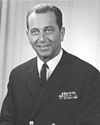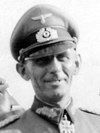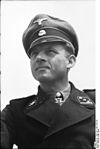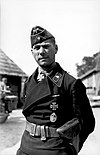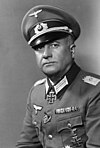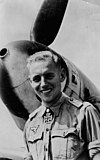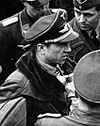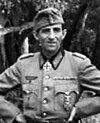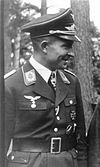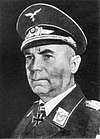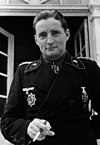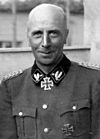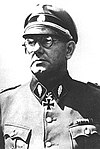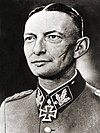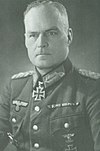List of Knight's Cross of the Iron Cross with Oak Leaves recipients (1944)
The Knight's Cross of the Iron Cross (Ritterkreuz des Eisernen Kreuzes) and its variants were the highest awards in the military and paramilitary forces of Nazi Germany during World War II. This decoration was awarded for a wide range of reasons and across all ranks, from a senior commander for skilled leadership of his troops in battle to a low-ranking soldier for a single act of extreme gallantry. The Knight's Cross of the Iron Cross with Oak Leaves (Ritterkreuz des Eisernen Kreuzes mit Eichenlaub) was introduced on 3 June 1940 to further distinguish those who had already received the Knight's Cross of the Iron Cross and who continued to show merit in combat bravery or military success. A total of 7 awards were made in 1940; 50 in 1941; 111 in 1942; 192 in 1943; 328 in 1944, and 194 in 1945, giving a total of 882 recipients—excluding the 8 foreign recipients of the award.
The number of 882 Oak Leaves recipients is based on the analysis and acceptance of the order commission of the Association of Knight's Cross Recipients (AKCR).[1] However, author Veit Scherzer has challenged the validity of 27 of these listings.[2] With the exception of Hermann Fegelein, all of the disputed recipients had received the award in 1945, when the deteriorating situation during the final days of World War II in Germany left a number of nominations incomplete and pending in various stages of the approval process. Fegelein received the Oak Leaves in 1942, but was sentenced to death by Adolf Hitler and executed by SS-Gruppenführer Johann Rattenhuber's Reichssicherheitsdienst (RSD) on 28 April 1945 after a court-martial led by SS-Brigadeführer and Generalmajor of the Waffen-SS Wilhelm Mohnke. The sentence was carried out the same day. The death sentence, according to German law, resulted in the loss of all orders and honorary signs.[3]
Background
[edit]The Knight's Cross of the Iron Cross and its higher grades were based on four separate enactments. The first enactment, Reichsgesetzblatt I S. 1573 of 1 September 1939 instituted the Iron Cross (Eisernes Kreuz), the Knight's Cross of the Iron Cross and the Grand Cross of the Iron Cross (Großkreuz des Eisernen Kreuzes). Article 2 of the enactment mandated that the award of a higher class be preceded by the award of all preceding classes.[4] As the war progressed, some of the recipients of the Knight's Cross distinguished themselves further and a higher grade, the Oak Leaves to the Knight's Cross of the Iron Cross, was instituted. The Oak Leaves, as they were commonly referred to, were based on the enactment Reichsgesetzblatt I S. 849 of 3 June 1940.[5] In 1941, two higher grades of the Knight's Cross were instituted. The enactment Reichsgesetzblatt I S. 613 of 28 September 1941 introduced the Knight's Cross of the Iron Cross with Oak Leaves and Swords (Ritterkreuz des Eisernen Kreuzes mit Eichenlaub und Schwertern) and the Knight's Cross of the Iron Cross with Oak Leaves, Swords and Diamonds (Ritterkreuz des Eisernen Kreuzes mit Eichenlaub, Schwertern und Brillanten).[6] At the end of 1944 the final grade, the Knight's Cross of the Iron Cross with Golden Oak Leaves, Swords, and Diamonds (Ritterkreuz des Eisernen Kreuzes mit goldenem Eichenlaub, Schwertern und Brillanten), based on the enactment Reichsgesetzblatt 1945 I S. 11 of 29 December 1944, became the final variant of the Knight's Cross authorized.[7]
Recipients of 1944
[edit]| Year | Number of presentations | Posthumous presentations |
|---|---|---|
| 1940 | ||
| 1941 | ||
| 1942 | ||
| 1943 | ||
| 1944 | ||
| 1945 |
The Oberkommando der Wehrmacht (Supreme Command of the Armed Forces) kept separate Knight's Cross lists, one for each of the three military branches, Heer (Army), Kriegsmarine (Navy), Luftwaffe (Air force) and for the Waffen-SS. Within each of these lists a unique sequential number was assigned to each recipient. The same numbering paradigm was applied to the higher grades of the Knight's Cross, one list per grade. [8] Of the 328 awards made in 1944, 46 presentations were made posthumously. Heer members received 198 of the medals, 13 went to the Kriegsmarine, 90 to the Luftwaffe, and 27 to the Waffen-SS.[9]
The Knight's Cross of the Iron Cross with Oak Leaves and Swords was awarded to 46 of the 328 Oak Leaves recipients of 1944.[1] Out of these 46 presentations, Veit Scherzer disputed eight of them for reasons associated to the deteriorating situation of Germany during the final days of World War II.[2] The sequential numbers greater than 143 for the Knight's Cross of the Iron Cross with Oak Leaves and Swords are unofficial and were assigned by the Association of Knight's Cross Recipients (AKCR) and are therefore denoted in parentheses.[10] The recipients are ordered and numbered chronologically. The rank listed is the recipient's rank at the time the Knight's Cross with Oak Leaves was awarded.
Legend:
Notes
[edit]- ^ For an explanation of the various naming schemes used by the Luftwaffe, Heer, Kriegsmarine, and Waffen-SS refer to nomenclature used by the Wehrmacht and Waffen-SS.
- ^ a b In German a Doctor of Law is abbreviated as Dr. iur. (Doctor iuris) or Dr. jur. (Doctor juris)
- ^ In German an engineer's degree is called Diplom-Ingenieur (abbreviated Dipl.-Ing.)
- ^ a b According to Scherzer as SS-Untersturmführer of the Reserves and Zugführer (platoon leader) in the 13.(schwere)/SS-Panzer-Regiment 1.[32]
- ^ According to Scherzer as Hauptmann and not as Hauptmann of the Reserves.[38]
- ^ According to Scherzer as Leutnant and not as Leutnant of the Reserves.[42]
- ^ In German a Doctor of Medical Dentistry is abbreviated as Dr. med. dent. (Doctor medicinae dentariae).
- ^ According to Scherzer as commander of Infanterie-Regiment 366.[58]
- ^ In German a Doctorate of Economics is abbreviated as Dr. rer. pol. (Doctor rerum politicarum).
- ^ According to Scherzer as commander of the III./Fallschirmjäger-Regiment 3.[66]
- ^ According to Scherzer as Staffelkapitän of the 9./Jagdgeschwader 52.[72]
- ^ According to Scherzer as Oberwachtmeister and not Wachtmeister.[88]
- ^ According to Scherzer as Major and not Oberstleutnant.[95]
- ^ According to Scherzer as Hauptmann and not as Major.[97]
- ^ According to Scherzer as Major of the Reserves.[101]
- ^ In German a Doctorate of Economics is abbreviated as Dr. rer. pol. (Doctor rerum politicarum) and a Doctorate in engineering is abbreviated as Dr.-Ing. (Doctor-Ingenieur).
- ^ According to Scherzer on 25 April 1944.[112]
- ^ According to Scherzer on 25 April 1944.[113]
- ^ According to Scherzer on 25 April 1944.[114]
- ^ The German Federal Archives hold no records for the presentation of the Swords. The Association of Knight's Cross Recipients (AKCR) assumes that the presentation fell into the timeframe 20 April 1945 to 29 April 1945. It is assumed that the nomination was approved on 26 April 1945.[116] Scherzer states that the assumption is based on a statement from Decker's widow. She claimed that she had been informed that her husband had received the award. The date and sequential number "149" were assigned by the AKCR.[117]
- ^ According to Scherzer as Staffelkapitän of the 5./Jagdgeschwader 3 "Udet".[121]
- ^ According to Scherzer as Oberstleutnant.[62]
- ^ According to Scherzer as Major and not as Major of the Reserves.[130]
- ^ According to Scherzer as commander of the 9. Flak-Division.[136]
- ^ According to Scherzer the Swords to the Knight's Cross of the Iron Cross with Oak Leaves were awarded on 3 August 1944.[152]
- ^ Fritz-Hubert Gräser's nomination was received by the Heerespersonalamt (HPA—Army Personnel Office) on 29 April 1945. General Ernst Maisel noted: "I approve the nomination! 30 April". The nomination list for the higher grades of the Knight's Cross of the Iron Cross only notes the nomination entry date as 29 April 1945. There is no indication that the award was granted. The paperwork was not finalized by the end of the war. The Association of Knight's Cross Recipients (AKCR) claims that the award was presented in accordance with the Dönitz-decree. This is illegal according to the Deutsche Dienststelle (WASt) and lacks legal justification. The sequential number "154" and presentation date were assigned by the AKCR.[160]
- ^ According to Scherzer as leader of the III./Jagdgeschwader 52.[168]
- ^ According to Scherzer as Hauptmann (war officer).[170]
- ^ According to Scherzer as Major.[172]
- ^ No evidence of the presentation of the award to Wilhelm Bittrich can be found in the German Federal Archives. The award was unlawfully presented by SS-Oberstgruppenführer Sepp Dietrich. The date is taken from the announcement made by the 6. SS-Panzerarmee. The sequential number "153" was assigned by the Association of Knight's Cross Recipients (AKCR). Bittrich was member of the AKCR.[197]
- ^ Eugen Meindl's nomination was approved by each of his commanding officers. However the nomination contains no final remark on the proceedings. Oberst Nicolaus von Below, Hitler's Luftwaffe adjutant, had sent a teleprinter message to the commanding general of the Fallschirmarmee Generaloberst Kurt Student, requesting a statement for this nomination. The copy of the teleprinter message contains a note: resubmission "23 April 1945". It seems that the statement was never returned. The paperwork was not finalized by the end of the war. The Association of Knight's Cross Recipients (AKCR) claims that the award was presented in accordance with the Dönitz-decree. This is illegal according to the Deutsche Dienststelle (WASt) and lacks legal justification. The sequential number "155" was assigned by the AKCR. Fellgiebel assigned the presentation date. Meindl is mentioned on a list of the Oberbefehlshaber Nordwest for "Nominations and Bestowal of War Awards" from May 1945. This list, which was intended to be presented to Karl Dönitz, contained twelve names of pending nominations which had been submitted via the chain of command. Dönitz never signed this list and it is believed that he never saw it. The responsible personnel offices awarded or declined eight nominations from this list by the end of the war by, two remained unprocessed by the Heerespersonalamt (HPA—Army Personnel Office) and Luftwaffenpersonalamt (LPA—Luftwaffe Personnel Office) and two further were left ready for signing at the Oberkommando der Wehrmacht/Wehrmacht-Führungsstab (OKW/WFSt—Oberkommando der Wehrmacht/Wehrmacht-Führungsstab—leadership staff of the Army High Command).[199]
- ^ Heinrich von Lüttwitz's nomination was received by the Heerespersonalamt (HPA—Army Personnel Office) on 28 April 1945. Major Joachim Domaschk decided on 30 April: "Heeresgruppe B, postpone!" General Von Lüttwiz together with the remaining forces of the Heeresgruppe B was either taken prisoner of war or missing in action in the Ruhr Pocket on 15 April. The nomination was thus not further processed in accordance with AHA 44 Ziff. 572. The nomination list for the higher grades of the Knight's Cross of the Iron Cross also contains a note from 28 April 1945: "postponed". A bestowal thus did not occur. The sequential number "157" and presentation date were assigned by the Association of Knight's Cross Recipients (AKCR).[206]
- ^ In German a Doctorate in engineering is abbreviated as Dr.-Ing. (Doctor-Ingenieur).
- ^ According to Scherzer as commander of SS-Panzer-Regiment 9.[229]
- ^ In German a Doctor of Law is abbreviated as Dr. iur. (Doctor iuris) or Dr. jur. (Doctor juris) and a Doctorate of Economics is abbreviated as Dr. rer. pol. (Doctor rerum politicarum).
- ^ According to Scherzer as Gruppenkommandeur of the II./Schlachtgeschwader 103.[246]
- ^ a b According to Scherzer on 18 October 1944 as leader of the III./Schlachtgeschwader 77.[169]
- ^ Karl Thieme's nomination was received by the Heerespersonalamt (HPA—Army Personnel Office) on 10 April 1945 via teleprinter message. Major Joachim Domaschk noted "By no means sufficient! Requesting statement from OB West", which was requested on 13 April. OB West responded on 24 April (entry date at the Heerespersonalamt on 28 April): "Statement from OB West not possible, since nomination was not made via OB West". Major Domaschk then decided on 28 April: "Heeresgruppe B, postpone!" In this instance the nomination was not processed due to AHA 44 Ziff. 572 but also because statements from his commanding officers could not be obtained anymore due to the capitulation. The nomination list for the higher grades of the Knight's Cross of the Iron Cross also contains a note from 10 April 1945: postponed. A bestowal thus did not occur. The Association of Knight's Cross Recipients (AKCR) claims that the award was presented in accordance with the Dönitz-decree. This is illegal according to the Deutsche Dienststelle (WASt) and lacks legal justification. The sequential number "156" was assigned by the AKCR. Fellgiebel assigned the presentation date.[256]
- ^ According to Scherzer on 18 October 1944.[264]
- ^ In German a Doctorate in Veterinary medicine is abbreviated as Dr. med. vet. (Doctor medicinae veterinariae).
- ^ According to Scherzer as commander of Panzer-Abteilung 2104.[62]
- ^ According to Scherzer as Staffelkapitän of the Aufklärungsstaffel 4.(F)/11.[276]
- ^ According to Scherzer as Hauptmann (War Officer).[277]
- ^ According to Scherzer as Kapitänleutnant (Marine Artillerie M.A.—Naval artillery) and not Korvettenkapitän (M.A.). Hans Hoßfeld was promoted to Korvettenkapitän (M.A.) posthumously.[282]
- ^ According to Scherzer as Major of the Reserves.[289]
- ^ According to Scherzer as Staffelkapitän in the III./Kampfgeschwader 1 "Hindenburg".[291]
- ^ According to Scherzer as leader of the II. Zug/ 8./Grenadier-Regiment 308.[294]
- ^ No evidence of the award can be found in the German Federal Archives. The award was unlawfully presented by SS-Oberstgruppenführer Sepp Dietrich. The date is taken from the announcement made by the 6. SS-Panzerarmee. The sequential number "151" was assigned by the Association of Knight's Cross Recipients (AKCR). Wisliceny was member of the AKCR.[303]
- ^ No evidence of the award can be found in the German Federal Archives. The award was unlawfully presented by SS-Oberstgruppenführer Sepp Dietrich. The date is taken from the announcement made by the 6. SS-Panzerarmee. The sequential number "150" was assigned by the Association of Knight's Cross Recipients (AKCR). Weidinger was member of the AKCR.[304]
References
[edit]Citations
[edit]- ^ a b Fellgiebel 2000, pp. 53–104.
- ^ a b Scherzer 2007, pp. 117–186.
- ^ Scherzer 2007, pp. 110–116, 128.
- ^ "Reichsgesetzblatt Teil I S. 1573; 1 September 1939" (PDF). ALEX Österreichische Nationalbibliothek (in German). Reichsministerium des Inneren (Ministry of the Interior). Archived from the original on 31 March 2019. Retrieved 21 February 2008.
- ^ "Reichsgesetzblatt Teil I S. 849; 3 June 1940" (PDF). ALEX Österreichische Nationalbibliothek (in German). Reichsministerium des Inneren (Ministry of the Interior). Archived from the original on 31 March 2019. Retrieved 21 February 2008.
- ^ "Reichsgesetzblatt Teil I S. 613; 28 September 1941" (PDF). ALEX Österreichische Nationalbibliothek (in German). Reichsministerium des Inneren (Ministry of the Interior). Archived from the original on 31 March 2019. Retrieved 21 February 2008.
- ^ "Reichsgesetzblatt 1945 I S. 11; 29 December 1944" (PDF). ALEX Österreichische Nationalbibliothek (in German). Reichsministerium des Inneren (Ministry of the Interior). Archived from the original on 31 March 2019. Retrieved 21 February 2008.
- ^ Fellgiebel 2000, p. 112.
- ^ Fellgiebel 2000, pp. 76–94.
- ^ Fellgiebel 2000, pp. 49–51.
- ^ a b c Scherzer 2007, p. 451.
- ^ a b c d e f g h i j k l Fellgiebel 2000, p. 76.
- ^ a b c Scherzer 2007, p. 304.
- ^ a b c Scherzer 2007, p. 472.
- ^ a b c Scherzer 2007, p. 365.
- ^ a b c d e f Scherzer 2007, p. 716.
- ^ a b c Scherzer 2007, p. 429.
- ^ a b c d e f g Scherzer 2007, p. 560.
- ^ a b c Scherzer 2007, p. 318.
- ^ a b c Scherzer 2007, p. 664.
- ^ a b c Scherzer 2007, p. 232.
- ^ a b c d e f g h i j k l m n o p q r s Fellgiebel 2000, p. 77.
- ^ a b c Scherzer 2007, p. 668.
- ^ a b c d e f Scherzer 2007, p. 785.
- ^ a b c d e f g h i Scherzer 2007, p. 479.
- ^ a b c Scherzer 2007, p. 461.
- ^ a b c d e f Scherzer 2007, p. 468.
- ^ a b c d e f Scherzer 2007, p. 371.
- ^ a b c d Scherzer 2007, p. 586.
- ^ a b c d e f g Scherzer 2007, p. 321.
- ^ a b c d e f Scherzer 2007, p. 705.
- ^ a b c d e f g h i Scherzer 2007, p. 793.
- ^ a b c d e f Scherzer 2007, p. 310.
- ^ a b c d Scherzer 2007, p. 374.
- ^ a b c d e f g Scherzer 2007, p. 383.
- ^ a b c Scherzer 2007, p. 464.
- ^ a b c Scherzer 2007, p. 512.
- ^ a b c d e f Scherzer 2007, p. 391.
- ^ a b c d e f Scherzer 2007, p. 242.
- ^ a b c d e f g h i j k l m n o p q Fellgiebel 2000, p. 78.
- ^ a b c Scherzer 2007, p. 528.
- ^ a b c Scherzer 2007, p. 676.
- ^ a b c Scherzer 2007, p. 549.
- ^ a b c d Scherzer 2007, p. 442.
- ^ a b c d e f g Scherzer 2007, p. 427.
- ^ a b c d e f g Scherzer 2007, p. 790.
- ^ a b c Scherzer 2007, p. 246.
- ^ a b c d e f Scherzer 2007, p. 514.
- ^ a b c Scherzer 2007, p. 496.
- ^ a b c Scherzer 2007, p. 432.
- ^ a b c d e f g h i j k Scherzer 2007, p. 681.
- ^ a b c Scherzer 2007, p. 722.
- ^ a b c Scherzer 2007, p. 504.
- ^ a b c d e f Scherzer 2007, p. 428.
- ^ a b c d e f g Scherzer 2007, p. 196.
- ^ a b c d e f Scherzer 2007, p. 463.
- ^ a b c d e f g h i j k l m n o p q r s t u Fellgiebel 2000, p. 79.
- ^ a b c Scherzer 2007, p. 778.
- ^ a b c d e f g h i Scherzer 2007, p. 546.
- ^ a b c Scherzer 2007, p. 214.
- ^ a b c Scherzer 2007, p. 314.
- ^ a b c d e f g h i j k l m Scherzer 2007, p. 773.
- ^ a b c d e f g h i Scherzer 2007, p. 544.
- ^ a b c d e f g Scherzer 2007, p. 401.
- ^ a b c d Scherzer 2007, p. 767.
- ^ a b c d Scherzer 2007, p. 375.
- ^ a b c d Scherzer 2007, p. 250.
- ^ a b c Scherzer 2007, p. 188.
- ^ a b c Scherzer 2007, p. 329.
- ^ a b c d e f Scherzer 2007, p. 315.
- ^ a b c Scherzer 2007, p. 700.
- ^ a b c d Scherzer 2007, p. 368.
- ^ a b c d Scherzer 2007, p. 212.
- ^ a b c Scherzer 2007, p. 733.
- ^ a b c d e f g h i j k l m n o p q r s t Fellgiebel 2000, p. 80.
- ^ a b c d e f Scherzer 2007, p. 744.
- ^ a b c Scherzer 2007, p. 624.
- ^ a b c d e f g h i j Scherzer 2007, p. 519.
- ^ a b c Scherzer 2007, p. 241.
- ^ a b c d Scherzer 2007, p. 690.
- ^ a b c Scherzer 2007, p. 415.
- ^ a b c Scherzer 2007, p. 423.
- ^ a b c Scherzer 2007, p. 673.
- ^ a b c Scherzer 2007, p. 580.
- ^ a b c Scherzer 2007, p. 199.
- ^ a b c Scherzer 2007, p. 352.
- ^ a b c d Scherzer 2007, p. 749.
- ^ a b c Scherzer 2007, p. 589.
- ^ a b c d e f Scherzer 2007, p. 702.
- ^ a b c d e f g h i j k l m n o p q r s Fellgiebel 2000, p. 81.
- ^ a b c Scherzer 2007, p. 557.
- ^ a b c Scherzer 2007, p. 791.
- ^ a b c d e f Scherzer 2007, p. 697.
- ^ a b c d Scherzer 2007, p. 476.
- ^ a b c Scherzer 2007, p. 610.
- ^ a b c Scherzer 2007, p. 349.
- ^ a b c d Scherzer 2007, p. 643.
- ^ a b c Scherzer 2007, p. 491.
- ^ a b c d e f g Scherzer 2007, p. 444.
- ^ a b c Scherzer 2007, p. 680.
- ^ a b c Scherzer 2007, p. 384.
- ^ a b c d e f Scherzer 2007, p. 360.
- ^ a b c d Scherzer 2007, p. 532.
- ^ a b c Scherzer 2007, p. 330.
- ^ a b c d e f Scherzer 2007, p. 759.
- ^ a b c d e f g Scherzer 2007, p. 564.
- ^ a b c d e f g h i j k l m n o p q r s t u v w x y Fellgiebel 2000, p. 82.
- ^ a b c Scherzer 2007, p. 280.
- ^ a b c d Scherzer 2007, p. 691.
- ^ a b c d e f Scherzer 2007, p. 653.
- ^ a b c Scherzer 2007, p. 601.
- ^ a b c Scherzer 2007, p. 723.
- ^ a b c Scherzer 2007, p. 547.
- ^ a b c Scherzer 2007, p. 794.
- ^ a b c Scherzer 2007, p. 267.
- ^ Fellgiebel 2000, pp. 49–50.
- ^ Scherzer 2007, p. 125.
- ^ a b c d e f g h i Scherzer 2007, p. 288.
- ^ a b c Scherzer 2007, p. 517.
- ^ a b c Scherzer 2007, p. 270.
- ^ a b c Scherzer 2007, p. 559.
- ^ a b c d e f g Scherzer 2007, p. 648.
- ^ a b c Scherzer 2007, p. 407.
- ^ a b c Scherzer 2007, p. 760.
- ^ a b c Scherzer 2007, p. 766.
- ^ a b c Scherzer 2007, p. 555.
- ^ a b c Scherzer 2007, p. 672.
- ^ a b c d e f g h i j k l m n o p q r s t Fellgiebel 2000, p. 83.
- ^ a b c Scherzer 2007, p. 754.
- ^ a b c d e f Scherzer 2007, p. 527.
- ^ a b c Scherzer 2007, p. 771.
- ^ a b c d e f Scherzer 2007, p. 731.
- ^ a b c Scherzer 2007, p. 394.
- ^ a b c Scherzer 2007, p. 378.
- ^ a b c Scherzer 2007, p. 393.
- ^ a b c d e f Scherzer 2007, p. 594.
- ^ a b c d e f g Scherzer 2007, p. 770.
- ^ a b c d e f Scherzer 2007, p. 568.
- ^ a b c Scherzer 2007, p. 234.
- ^ a b c d e f Scherzer 2007, p. 595.
- ^ a b c d e f Scherzer 2007, p. 398.
- ^ a b c Scherzer 2007, p. 803.
- ^ a b c d e f Scherzer 2007, p. 277.
- ^ a b c Scherzer 2007, p. 431.
- ^ a b c d Scherzer 2007, p. 727.
- ^ a b c d e f g h i j k l m n o p q r s t Fellgiebel 2000, p. 84.
- ^ a b c Scherzer 2007, p. 590.
- ^ a b c Scherzer 2007, p. 271.
- ^ a b c Scherzer 2007, p. 526.
- ^ a b c Scherzer 2007, p. 249.
- ^ a b c Scherzer 2007, p. 433.
- ^ a b c d Scherzer 2007, p. 675.
- ^ a b c Scherzer 2007, p. 337.
- ^ a b c Scherzer 2007, p. 708.
- ^ a b c Scherzer 2007, p. 411.
- ^ a b c Scherzer 2007, p. 755.
- ^ a b c Scherzer 2007, p. 187.
- ^ a b c d e f g h i j k l m n o p q r s t u Fellgiebel 2000, p. 85.
- ^ a b c Scherzer 2007, p. 344.
- ^ Scherzer 2007, p. 134.
- ^ a b c d e f g Scherzer 2007, p. 645.
- ^ a b c d e f g h i Scherzer 2007, p. 799.
- ^ a b c d e f Scherzer 2007, p. 256.
- ^ a b c Scherzer 2007, p. 301.
- ^ a b c Scherzer 2007, p. 582.
- ^ Fellgiebel 2000, pp. 85, 479.
- ^ a b c d Scherzer 2007, p. 501.
- ^ a b c Scherzer 2007, p. 204.
- ^ a b c d e Scherzer 2007, p. 440.
- ^ a b c Scherzer 2007, p. 732.
- ^ a b c d e f Scherzer 2007, p. 781.
- ^ a b c Scherzer 2007, p. 490.
- ^ a b c d e f g h i j k l m n o p q r s t u Fellgiebel 2000, p. 86.
- ^ a b c Scherzer 2007, p. 257.
- ^ a b c d Scherzer 2007, p. 578.
- ^ a b c Scherzer 2007, p. 269.
- ^ a b c Scherzer 2007, p. 692.
- ^ a b c Scherzer 2007, p. 746.
- ^ a b c Scherzer 2007, p. 661.
- ^ a b c Scherzer 2007, p. 728.
- ^ a b c Scherzer 2007, p. 450.
- ^ a b c Scherzer 2007, p. 707.
- ^ a b c d e f Scherzer 2007, p. 470.
- ^ a b c Scherzer 2007, p. 197.
- ^ a b c d e f Scherzer 2007, p. 706.
- ^ a b c d e f g h i j k l m n o p q r Fellgiebel 2000, p. 87.
- ^ a b c Scherzer 2007, p. 521.
- ^ a b c Scherzer 2007, p. 768.
- ^ a b c Scherzer 2007, p. 693.
- ^ a b c Scherzer 2007, p. 536.
- ^ Fellgiebel 2000, pp. 87, 479.
- ^ a b c Scherzer 2007, p. 392.
- ^ a b c d Scherzer 2007, p. 522.
- ^ a b c Scherzer 2007, p. 402.
- ^ a b c Scherzer 2007, p. 592.
- ^ a b c d e f g Scherzer 2007, p. 224.
- ^ Scherzer 2007, p. 121.
- ^ a b c Scherzer 2007, p. 534.
- ^ Scherzer 2007, p. 159.
- ^ a b c d e f Scherzer 2007, p. 312.
- ^ a b c Scherzer 2007, p. 220.
- ^ a b c Scherzer 2007, p. 446.
- ^ a b c Scherzer 2007, p. 326.
- ^ a b c Scherzer 2007, p. 227.
- ^ a b c d e f g h i j k l m n o p q r s t u Fellgiebel 2000, p. 88.
- ^ Scherzer 2007, p. 157.
- ^ a b c Scherzer 2007, p. 347.
- ^ a b c Scherzer 2007, p. 710.
- ^ a b c Scherzer 2007, p. 591.
- ^ Fellgiebel 2000, pp. 88, 480.
- ^ a b c Scherzer 2007, p. 495.
- ^ a b c Scherzer 2007, p. 769.
- ^ a b c Scherzer 2007, p. 507.
- ^ a b c Scherzer 2007, p. 230.
- ^ a b c Scherzer 2007, p. 619.
- ^ a b c Scherzer 2007, p. 332.
- ^ a b c Scherzer 2007, p. 750.
- ^ a b c Scherzer 2007, p. 809.
- ^ a b c Scherzer 2007, p. 552.
- ^ a b c Scherzer 2007, p. 359.
- ^ a b c d e f g h i j k l m n o p q r Fellgiebel 2000, p. 89.
- ^ a b c Scherzer 2007, p. 694.
- ^ a b c Scherzer 2007, p. 229.
- ^ a b c Scherzer 2007, p. 209.
- ^ a b c Scherzer 2007, p. 553.
- ^ a b c Scherzer 2007, p. 459.
- ^ a b c d e f Scherzer 2007, p. 593.
- ^ a b c d Scherzer 2007, p. 474.
- ^ a b c Scherzer 2007, p. 542.
- ^ a b c Scherzer 2007, p. 657.
- ^ a b c Scherzer 2007, p. 652.
- ^ Fellgiebel 2000, pp. 89, 480.
- ^ a b c Scherzer 2007, p. 254.
- ^ a b c Scherzer 2007, p. 211.
- ^ a b c Scherzer 2007, p. 485.
- ^ a b c d e f g h i j k l m n o p q r s t u Fellgiebel 2000, p. 90.
- ^ a b c Scherzer 2007, p. 462.
- ^ a b c Scherzer 2007, p. 620.
- ^ a b c Scherzer 2007, p. 729.
- ^ a b c Scherzer 2007, p. 632.
- ^ a b c Scherzer 2007, p. 438.
- ^ a b c Scherzer 2007, p. 456.
- ^ a b c d e f Scherzer 2007, p. 417.
- ^ a b c d e f Scherzer 2007, p. 686.
- ^ a b c Scherzer 2007, p. 389.
- ^ a b c Scherzer 2007, p. 205.
- ^ a b c Scherzer 2007, p. 225.
- ^ a b c d Scherzer 2007, p. 425.
- ^ a b c d e f Scherzer 2007, p. 626.
- ^ a b c Scherzer 2007, p. 356.
- ^ a b c d Scherzer 2007, p. 475.
- ^ a b c d e f g h i j k l m n o p q r s t u Fellgiebel 2000, p. 91.
- ^ a b c Scherzer 2007, p. 777.
- ^ a b c Scherzer 2007, p. 742.
- ^ Fellgiebel 2000, pp. 91, 480.
- ^ Scherzer 2007, p. 179.
- ^ a b c Scherzer 2007, p. 725.
- ^ a b c Scherzer 2007, p. 656.
- ^ a b c Scherzer 2007, p. 500.
- ^ a b c Scherzer 2007, p. 748.
- ^ a b c Scherzer 2007, p. 625.
- ^ a b c Scherzer 2007, p. 286.
- ^ a b c Scherzer 2007, p. 689.
- ^ a b c Scherzer 2007, p. 248.
- ^ a b c Scherzer 2007, p. 390.
- ^ a b c Scherzer 2007, p. 320.
- ^ a b c Scherzer 2007, p. 305.
- ^ a b c Scherzer 2007, p. 287.
- ^ a b c Scherzer 2007, p. 369.
- ^ a b c d e f g h i j k l m n o p q r s t u v Fellgiebel 2000, p. 92.
- ^ a b c Scherzer 2007, p. 776.
- ^ a b c Scherzer 2007, p. 802.
- ^ a b Fellgiebel 2000, pp. 92, 480.
- ^ a b c d e f g Scherzer 2007, p. 276.
- ^ a b c Scherzer 2007, p. 478.
- ^ a b c Scherzer 2007, p. 198.
- ^ a b c Scherzer 2007, p. 541.
- ^ a b c Scherzer 2007, p. 193.
- ^ a b c Scherzer 2007, p. 395.
- ^ a b c Scherzer 2007, p. 663.
- ^ a b c Scherzer 2007, p. 699.
- ^ a b c Scherzer 2007, p. 406.
- ^ a b c Scherzer 2007, p. 599.
- ^ a b c Scherzer 2007, p. 623.
- ^ a b c Scherzer 2007, p. 278.
- ^ a b c Scherzer 2007, p. 437.
- ^ a b c d e f g h i j k l m n o p q r s t Fellgiebel 2000, p. 93.
- ^ a b c Scherzer 2007, p. 543.
- ^ a b c Scherzer 2007, p. 223.
- ^ a b c Scherzer 2007, p. 289.
- ^ a b c Scherzer 2007, p. 524.
- ^ a b c Scherzer 2007, p. 651.
- ^ a b c Scherzer 2007, p. 361.
- ^ a b c Scherzer 2007, p. 240.
- ^ a b c Scherzer 2007, p. 194.
- ^ a b c Scherzer 2007, p. 294.
- ^ a b c Scherzer 2007, p. 764.
- ^ a b c Scherzer 2007, p. 404.
- ^ a b c Scherzer 2007, p. 263.
- ^ a b c Scherzer 2007, p. 482.
- ^ a b c d Scherzer 2007, p. 221.
- ^ a b c d Fellgiebel 2000, p. 94.
- ^ Scherzer 2007, p. 185.
- ^ Scherzer 2007, p. 184.
Bibliography
[edit]- Fellgiebel, Walther-Peer [in German] (2000) [1986]. Die Träger des Ritterkreuzes des Eisernen Kreuzes 1939–1945 — Die Inhaber der höchsten Auszeichnung des Zweiten Weltkrieges aller Wehrmachtteile [The Bearers of the Knight's Cross of the Iron Cross 1939–1945 — The Owners of the Highest Award of the Second World War of all Wehrmacht Branches] (in German). Friedberg, Germany: Podzun-Pallas. ISBN 978-3-7909-0284-6.
- Scherzer, Veit (2007). Die Ritterkreuzträger 1939–1945 Die Inhaber des Ritterkreuzes des Eisernen Kreuzes 1939 von Heer, Luftwaffe, Kriegsmarine, Waffen-SS, Volkssturm sowie mit Deutschland verbündeter Streitkräfte nach den Unterlagen des Bundesarchives [The Knight's Cross Bearers 1939–1945 The Holders of the Knight's Cross of the Iron Cross 1939 by Army, Air Force, Navy, Waffen-SS, Volkssturm, and Allied Forces with Germany According to the Documents of the Federal Archives] (in German). Jena, Germany: Scherzers Miltaer-Verlag. ISBN 978-3-938845-17-2.
External links
[edit]- "Das Bundesarchiv". Military Archive - Freiburg im Breisgau. Archived from the original on 29 December 2010. Retrieved 2 January 2011.


